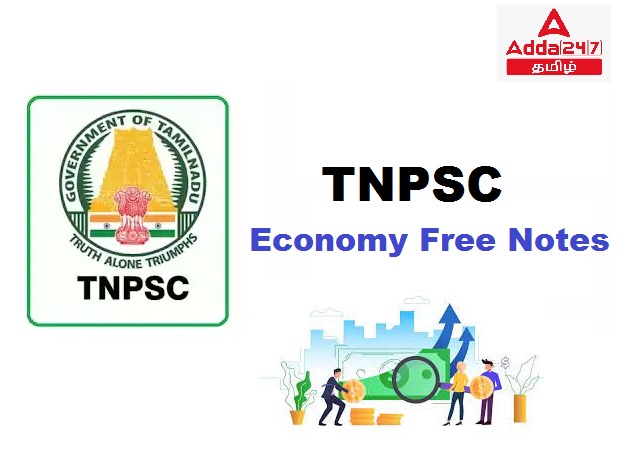இந்தக் கட்டுரையில், TNPSC குரூப் 1, குரூப் 2, குரூப் 2A, குரூப் 4 மாநிலப் போட்டித் தேர்வுகளான TNUSRB, TRB, TET, TNEB போன்றவற்றுக்கான முறைகள் இலவசக் குறிப்புகளைப் பெறுவீர்கள்.தேர்வுக்கு தயாராவோர் இங்குள்ள பாடக்குறிப்புகளை படித்து பயன்பெற வாழ்த்துகிறோம்.
Money
Introduction
Money is anything that is generally accepted as payment for goods and services and
repayment of debts and that serves as a medium of exchange.
A medium of exchange is anything that is widely accepted as a means of payments.
In recent years, the importance of credit has increased in all the countries of the world.
Credit instruments are used on an extensive scale. The use of cheques, bills of exchange,
etc. has gone up. It should however, be remembered that money is the basis of credit.
Evolution of Money
Barter System
Before money was invented, exchange took place by Barter, that is, commodities and
services were directly exchanged for other commodities and services.
Surplus goods were exchanged for money which in turn was exchanged for other
needed goods.
Goods like furs, skins, salt, rice, wheat, utensils, weapons, etc. were commonly used as
money.
Such an exchange of goods for goods was known as “Barter Exchange” or “Barter
System”.
The history of the Barter system starts its way back in 6000 BC.
Barter system was introduced by Mesopotamia tribes.
Phoenicians adopted bartering of goods with various other cities across oceans.
Babylonian’s also developed an improved barter system, where goods were exchanged
for goods.
Metallic Standard
After the barter system and commodity money system, modern money systems
evolved. Among these, the metallic standard is the premier one.
Under the metallic standard, some kind of metal, either gold or silver, is used to
determine the standard value of the money and currency.
Standard coins made out of the metal are the principal coins used under the metallic
standard.
These standard coins are full bodied or full weighted legal tender. Their face value is
equal to their intrinsic metal value.
Gold Standard
The monetary unit is defined in terms of a certain weight of gold.
The purchasing power of a unit of money is maintained equal to the value of a fixed
weight of gold.
Silver Standard
The silver standard is a monetary system in which the standard economic unit of account is a
fixed weight of silver.
Paper Currency Standard
The paper currency standard refers to the monetary system in which the paper currency
notes issued by the Treasury or the Central Bank or both, circulate as unlimited legal
tender.
Its value is determined, independent of the value of gold or any other commodity.
The paper standard is also known as managed currency standard.
The quantity of money in circulation is controlled by the monetary authority to maintain
price stability.
Plastic Money
Plastic money is one of the most evolved forms of financial products. Plastic money is an
alternative to the cash or the standard “money”.
Plastic money is a term that is used predominantly in reference to the hard plastic cards
used every day in place of actual banknotes.
Plastic money can comes in many different forms such as Cash cards, Credit cards, Debit
cards, Pre-paid Cash cards, Store cards, Forex cards and Smart cards.
They aim at removing the need for carrying cash to make transactions.
Crypto Currency
A digital currency in which encryption techniques are used to regulate the generation of
units of currency and verify the transfer of funds, operating independently of a Central
Bank.
Decentralised crypto currencies such as Bitcoin now provide an outlet for Personal
wealth that is beyond restriction and confiscation.
Supply of Money
Money supply means the total amount of money in an economy.
Money supply plays a crucial role in the determination of price level and interest rates.
Money supply viewed at a given point of time is a stock and over a period of time it is a
flow.
Meaning of Money Supply
In India, currency notes are issued by the Reserve Bank of India (RBI) and coins are
issued by the Ministry of Finance, Government of India (GOI).
Besides these, the balance is savings, or current account deposits, held by the public in
commercial banks is also considered money.
The currency notes are also called fiat money and legal tenders.
Money supply is a stock variable. RBI publishes information for four alternative
measures of Money supply, namely M1, M2, M3 and M4.
M1 = Currency, coins and demand deposits,
M2 = M1 + Savings deposits with post office savings banks,
M3 = M2 + Time deposits of all commercial and cooperative banks,
M4 = M3 + Total deposits with Post offices.
M1 and M2 are known as narrow money.
M3 and M4 are known as broad money.
Currency Symbol
The new symbol designed by D.Udaya Kumar, a post graduate of IIT Bombay was finally
selected by the Union cabinet on 15 th July, 2010.
The new symbol is an amalgamation of Devanagri ‘Ra’ and the Roman ‘R’ without the
stem.
The symbol of India rupee came into use on 15 th July, 2010. After America, Britain, Japan, Europe
Union, India is the 5th country to accept a unique currency symbol
**************************************************************************
| Adda247 TamilNadu Home page | Click here |
| Official Website=Adda247 | Click here |




